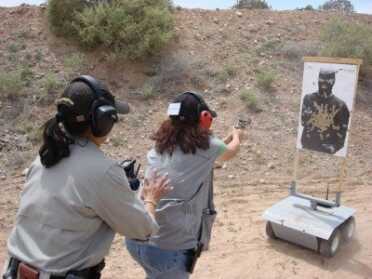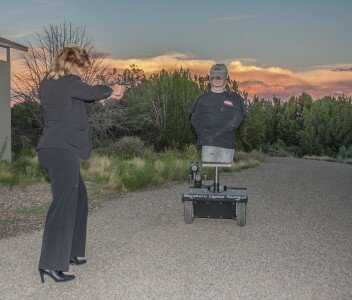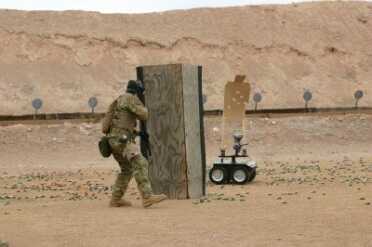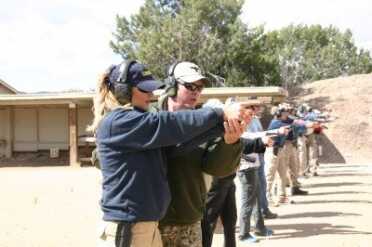Cory Trapp
Gunsite Academy
https://www.gunsite.com/main/
As a Rangemaster at Gunsite Academy, I see clients learning numerous new techniques and tactics through the dozens of courses we teach year round. But for every person who comes to Gunsite, there are thousands who may not be able to afford the trip, or who think that they are good enough with their personal defense firearms to not require any formal training. Many people are involved in self-defense shootings every year, and it would appear that most of them have very little effective training. Some survive the event, some don’t. Of those who do survive, do we credit skill or random chance? More important, what do YOU want to depend on if the fight comes to you? The choice is yours, good fortune or superior skills. The majority of gunfights happen in seconds, generally without much warning and at very close range. It does not take an extraordinary amount of marksmanship to hit a person in the chest at three feet. Most people don’t realize that most gunfights share some very common aspects, and training for these aspects will give you the skills to win.
Most people with even a casual interest in self-defense can recall the FBI statistics of the mythical “average gunfight”. The event lasts 2.5 seconds, takes about 3-5 rounds and the average range is 7 yards. The problem is that these average numbers do not tell a complete story. For example, while the average range is 21 feet, 90% of the events took place at five feet OR LESS. The average is skewed by the occasional across the street or parking lot affair. Think about it, you don’t get mugged from seven yards. The same thing is happening to the time and round count, the average is not a reliable representation of the whole story. So, with all that said, just what should we be training?
Understand that there are two types of fights, proactive and reactive. Proactive fights are when we get the jump on the bad guy and we can end the fight before he even knows it’s started. If you are alert, fully aware of your surroundings and truly believe that today could be the day you have to shoot for blood, you are way ahead of the game. These are the fights that most civilians and police do well in, basic square range marksmanship skills serve them well. Proactive fights are not the most common type though, and plain old stand on line at 5 yards and fire two shots center mass is not the skill set that works best the rest of the time.
For the reactive fight, where we have somehow failed to perceive the problem before it occurs, we need an advanced skill set, and it needs to be highly developed. You must have a reflexive, reliable and FAST presentation (drawstroke). You must be able to index the gun on target, then instantly and smoothly fire rapid, accurate bursts. Finally, this must all be done while getting off the line of attack, MOVE. Without this combination of skills, you are basically dependent on your attacker(s) being totally incompetent. This is not a good position to be in. Sadly, most people who carry guns daily actually have almost NONE of this skill set. If you survey a group of shooters, and ask them to rank their own skill level, you’ll find that about 90% believe they are in the top 30-40%. Clearly that’s not possible, but most people have not only have an inflated view of their own skill level but no real understanding of what a truly skilled shooter can actually accomplish.
The presentation, for example, is rarely ever taught properly, and little if any time is spent by the average shooter on this critical process. Think about it—if you can’t get the gun from the holster to index on target, you can be the world champion marksman and so what, you don’t get to shoot. We teach the presentation in five counts: grip, clear, rotate, smack, look/press. We do one step at a time, correct any errors and do lots of repetitions. Once we get through all the individual steps, we run it by the numbers, slowly and step by step. The presentation consumes about half a day, and from then on you should be spending about thirty minutes each night in dry practice for two weeks, then every other night for a month, thereafter about once a week. Bear in mind that it takes about 5,000 repetitions of any set of movements to make it reflexive, where it can be done without thought. Also, practice does not make perfect, it makes permanent. Those 5,000 presentations must each themselves be perfect if you wish to be reasonably competent. A skilled individual can, on signal, fire a single headshot at five yards in one second, on demand, no ‘warm up’.
The program at Gunsite is based on the concept of the ‘flash sight picture’; we teach sighted fire. While point shooting, that is unsighted fire with no visual index, can certainly be developed to a very high degree, it’s simply easier to use the sights, and despite claims to the contrary it’s every bit as fast. This, of course, depends on using the concept correctly, and too often it’s not properly applied. This is not simply getting the front and rear sight into perfect alignment before you press the trigger. It is, in fact, not even required that you have a front and rear sight. Many times I have taken a new pistol build out the back door of the Gunsmithy and fired a test magazine of eight shots, getting five hits on the 25-yard 6” plate, and the slide does not even have dovetails yet, it’s bald. It’s not magic, and it’s NOT point shooting. The ‘sights’ are simply the profile of the slide itself. You need to build your visual reference system so you can see the alignment required to hit precisely, and that alignment itself lets you press the trigger. You can’t make that one-second headshot if you are trying to adjust the sight alignment at the end of the stroke. An exercise I run with every basic pistol class to get the point across works like this. At five yards, carefully fire one shot at the center of a target with bull’s-eye precision; take all the time you need for one perfect shot. Now, realign the sights on that hole. Move only the front sight to the right, until the edge is just out of the notch and no longer visible, then press the trigger. Repeat the process moving the sight to the left, then down, the up until the bottom of the blade is at the top of the notch. Look at the target. If you press the trigger well, you’ll see a + pattern, and the spread of the shots will be no more than 6-10”. Since five yards is actually a pretty long range for a gunfight, the question is, “How much sight picture do you need to see to get good hits?” The answer is, not a whole lot. Is the target behind the sight blade? You should be shooting, not trying to get a perfect sight picture. The best way to not get shot is to disable the bad guy so he can’t shoot. Getting good hits sooner is the key.
If not getting shot is a goal, then it is going to be helpful if you make it harder for the bad guy to hit you. While putting bullets into his vitals is good, moving at the same time is better. You must be able to execute that perfect drawstroke and shot while simultaneously moving out of the line of fire. In an ideal situation, you’d move off line at 10 or 1 o’clock, to the back side of your opponent’s weapon hand. With multiple attackers, move to put them in line, so it’s difficult for them all to engage while you get more target area yourself. The movement needs to be sharp, fast and in sync with the drawstroke. While you may be constrained by obstacles, ANY movement is better that standing still and trying to simply outdraw the bad guy. This is a skill set that can be well practiced just using blue guns or Airsoft replica guns with a training partner. DO NOT USE REAL FIREARMS WHEN TRAINING WITH A PERSON! Every ‘accidental’ shooting report starts with “Well, we were sure it was not loaded…” or words to that effect. Effective movement requires good instruction and a good deal of practice. It can be the deciding factor in getting through your fight without getting shot, and therefore merits serious attention.
Like any physical skill, professional instruction is required if you wish to perform it at a high level of competence. There is far more to any of these skills than be conveyed in a simple written article. You can’t learn to hit a golf ball like a pro by reading a book. Neither can you learn how to be a gunfighter. Think of the money you spend on professional instruction like insurance. Exactly how much is your life worth? These skills are like a life jacket or fire extinguisher. You probably won’t need to use them, but if you are the one that DOES, you’ll need them pretty bad.







I follow Jeff Cooper and his instruction. All of the “new” schools and their instructors don’t impress me at all. Gunsite wrote the book on self defense and I will follow them. Their instruction is timeless.
Question: I practice “getting off the X” while drawing but would moving to “the backside of your opponent’s weapon hand” as disclosed in your article potentially place his hand and arm in front of that part of the body you are trying to hit, in order to stop the threat? Trying to shoot through someone’s arm would make the spinal column even more difficult to hit.
In addition, for a right handed opponent, is there likely a general tendency for that opponent to move his weapon more easily to the right or left in order to follow your body’s movement while presenting your firearm? is that consistent with a left handed shooter? If it has been determined through study that right handed shooters, e.g. can follow with their weapon more easily to the right, I would want to move to his left to buy me that half second or two. Any insight on this fine point?
Please advise. Good stuff, thanks for the article.
RB
Chris:
Whatever, they call whatever stance their using it’s still a 50 year old out of date passe and an out of balance stance.
Back in the 60’s the US was getting badly beaten by the Russians in ISU Rifle. It was a time when Gary Anderson was a member of the USAMU. At one of the matches a member of the US team did a government job on the Russian training manual. It took one year to translate and two to completely change all positions, especially “off-hand.” Now the shooter is in balance with the bone structure supporting the rifle rather than the muscle structure of yore.
Evolutionary change needs to be brought into the modern day pistol stance. It has to be one that is skelatelly aligned and in balance to afford successfully engaging multiple targets while on the move. This allows for body indexing, cutting in half which is vital for teaching from retention at touching distances. Gunsite can’t do it, ergo can’t teach it. If you think they can. Show me the video. In fact show me the video from any trainer or academy.
The last time the Modfied Weaver technique was used to win an IPSC match at the National level “Celebration” by Kool and The Gang was topping the charts.
Times change, techniques improve. Olympic cross country skiers used to used “kick and glide” waaaay back when too before “skating” was developed. Skating trounced kick and glide and the world never looked back. Same thing here.
Bottom line, one can become an outstanding shooter using Modified Weaver. No question about that. But you won’t be able to achieve the maximum of your potential with it. No once teaches or uses it anymore except for old-time schools stuck in the dogma of the past. I will say this for it though, Modified Weaver looks waaay cooler than Modern Iso.! Just look at Jack Bauer!
CT
You are quite correct in the FBI shooting stats, it’s a pity that all the photos show arms fully extended. At touching distances they would be all dead. The problem you have at Gunsite is that you don’t have anyone who can shoot from retention,and on the move, required for baddies at 5 feet or less, ergo you can’t teach it. So all your trainees will die.
Gunsite is like all other training academies in the USA, they teach the same old push/pull Weaver/Isosceles stance, a 50 year out of date off balance technique.
Gunsite should have hired Kent Turnipseed when they had the chance. Yes, I’m, biased. Why? First,he’s the only person inducted into the Martial Arts Hall of Fame for The Martial Art of the Gun and that’s worldwide. Two, he’s the only one who teaches shooting from retention on the move because he and his associate Alan Egusa can do it. Watch his video at http://www.quickshoot.com
Show me your video!!!
I would have to respectfully disagree regarding Mr. Turnipseed’s “firsts.”
http://www.forceoptions.net/about.php
Although all the photos in the article do show the arms extended, it’s not true that Gunsite doesn’t have anyone who can shoot from retention or on the move. They have a great course titled Close Quarters Pistol that involves both armed and unarmed defense at close quarters which I took last year with my daughter. Shooting double taps with a .45 one-handed from retention position at a target within arms reach is not a lot of fun for your wrist, but you quickly learn how effective it is at close range.
http://www.gunsite.com/main/course-offerings/pistol/close-quarters-pistol/
What! An academy says you need to give them money! Isn’t this the same thing I just heard about on tv for 15 minute car insurance? Or was it the 7 minute car insurance? No offense but it’s pretty offensive to be told I’m too stupid to live. I wouldn’t dare say something to you about your being just another snake oil salesman. Do we need to learn a few things about guns to use them effectively? I didn’t just jump in a car and start driving. But I didn’t need to pay out huge amounts of money to get the idea of it all. I can read all sorts of training routines on the net for free. Before you say you get what you pay for I’d like to point out the history of the Edsel.
It’s fine to provide training to those who want it. But when someone starts telling me I desperately need something I start to think about mouthwash commercials. They created a whole industry out of the paranoia of the public. Yes some people have bad breath. But toothpaste will solve that problem for a lot less money.
I don’t like someone trying to goad me into buying their product. It’s that simple.
As a federal peace officer about to retire I’ve often debated the semi-auto v. revolver controversy. Most say “…revolvers are obsolete, what if?…” The FBI stats only reinforce my opinion you don’t a need a woodpecker to hit anything. If you need more than one cylinder to hit a perp in your average defensive shooting, then sorry but you $uck: In that case, get a Judge .410 with .00 or .000 buck. Otherwise, a hammerless S&W airweight snubby should serve you well and will even pack comfortably in a top pocket. Just my two cents.
I hear this argument fairly often, and the right response is this: “Okay, you got the first attacker. Now what are you going to do about his two accomplices?” Remember that wolves hunt in packs.
In 2008 while,listening Obama speech on D TV at D Dr’s office.I said 2 D audience in spanish “Ojala q. este mulato le salga a los Johnny’s mejor q. el Mulato Lindo de Batista nos salio a los cubanos en el 1940” “I hope that this mulatto will be better 4 d americans than the hand-some mulatto of Batista did 4 us cubans in 1940″I almost got mobbed by d old wenches present.One said 2 me”How dare U call the president of d USA a mulato! I answered “in Cuba as in d USA d son of a white mother & a black father is a mulato(mulatto).If want Barak Obama to be arian 4 U fine; and a terrorist fanatic as Nelson Candela is not a communist but liberal democrat also! Ask d pres.B. Obama.
Hey,
It is what it is. He (Obama) called himself, and nearly all Americans Mongrels. So why should it be bad when we use a common, albeit out dated term, like Mullato to refer to him? Please don’t start with that “racist” baloney, because this isn’t about race. Is it any worse than calling me a Kraut, or an Italian a “Dago”, or an Englishman a “Limey”? Think about it.